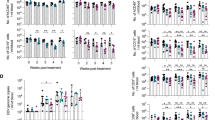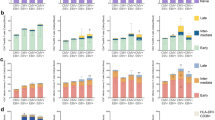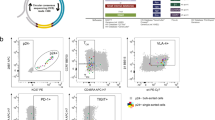Abstract
The Epstein–Barr virus (EBV) is carried by more than 90% of the adult world population and has been implicated in several human malignancies. Its ability to induce unlimited in vitro proliferation of B cells is frequently used to generate lymphoblastoid cell lines (LCLs). In this study, we have investigated the evolution of two LCLs up to 25 weeks after EBV infection. LCLs were karyotyped once a month by spectral karyotyping (SKY). LCLs but not mitogen-activated B cells showed evidence of DNA damage and DNA damage response within the first 2 weeks. After 4 weeks, the former, but not the latter, showed a high level of non-clonal structural aberrations, mainly deletions, fragments, dicentric chromosomes and unbalanced translocations. Genomic instability decreased thereafter over time. Nonrandom aneuploidy 12 weeks after infection showed clonal evolution in culture. After 25 weeks post-infection, most cells exhibited karyotypic stability. Chromosomal aberrations were compatible with telomere dysfunction, although in the absence of telomere shortening. The telomere capping protein TRF2 was partially displaced from telomeres in EBV-infected cells, suggesting an EBV-mediated uncapping problem. In conclusion, this study suggests that DNA damage and telomere dysfunction contribute to EBV-related chromosomal instability in early LCLs.
This is a preview of subscription content, access via your institution
Access options
Subscribe to this journal
Receive 50 print issues and online access
$259.00 per year
only $5.18 per issue
Buy this article
- Purchase on Springer Link
- Instant access to full article PDF
Prices may be subject to local taxes which are calculated during checkout







Similar content being viewed by others
References
Aubert G, Lansdorp PM . (2008). Telomeres and aging. Physiol Rev 88: 557–579.
Belfiore MC, Natoni A, Barzellotti R, Merendino N, Pessina G, Ghibelli L et al. (2007). Involvement of 5-lipoxygenase in survival of Epstein–Barr virus (EBV)-converted B lymphoma cells. Cancer Lett 254: 236–243.
Caporali A, Wark L, Vermolen BJ, Garini Y, Mai S . (2007). Telomeric aggregates and end-to-end chromosomal fusions require myc box II. Oncogene 26: 1398–1406.
Cerimele F, Battle T, Lynch R, Frank DA, Murad E, Cohen C et al. (2005). Reactive oxygen signaling and MAPK activation distinguish Epstein–Barr Virus (EBV)-positive versus EBV-negative Burkitt's lymphoma. Proc Natl Acad Sci USA 102: 175–179.
Chuang TC, Moshir S, Garini Y, Chuang AY, Young IT, Vermolen B et al. (2004). The three-dimensional organization of telomeres in the nucleus of mammalian cells. BMC Biol 2: 12.
Ciobanu N, Wiernik PH . (1986). Malignant lymphomas, AIDS, and the pathogenic role of Epstein–Barr virus. Mt Sinai J Med 53: 627–638.
Counter CM, Botelho FM, Wang P, Harley CB, Bacchetti S . (1994). Stabilization of short telomeres and telomerase activity accompany immortalization of Epstein–Barr virus-transformed human B lymphocytes. J Virol 68: 3410–3414.
de Lange T . (2005). Shelterin: the protein complex that shapes and safeguards human telomeres. Genes Dev 19: 2100–2110.
De Vos WH, Hoebe RA, Joss GH, Haffmans W, Baatout S, Van Oostveldt P et al. (2009). Controlled light exposure microscopy reveals dynamic telomere microterritories throughout the cell cycle. Cytometry A 75: 428–439.
Diehl V, Krause P, Hellriegel KP, Busche M, Schedel I, Laskewitz E . (1977). Lymphoid cell lines: in vitro cell markers in correlation to tumorigenicity in nude mice. Haematol Blood Transfus 20: 289–296.
Dolcetti R, Masucci MG . (2003). Epstein–Barr virus: induction and control of cell transformation. J Cell Physiol 196: 207–218.
Gargouri B, Van Pelt J, El Feki Ael F, Attia H, Lassoued S . (2009). Induction of Epstein–Barr virus (EBV) lytic cycle in vitro causes oxidative stress in lymphoblastoid B cell lines. Mol Cell Biochem 324: 55–63.
Garrone P, Neidhardt EM, Garcia E, Galibert L, van Kooten C, Banchereau J . (1995). Fas ligation induces apoptosis of CD40-activated human B lymphocytes. J Exp Med 182: 1265–1273.
Gordon J, Walker L, Guy G, Brown G, Rowe M, Rickinson A . (1986). Control of human B-lymphocyte replication. II. Transforming Epstein–Barr virus exploits three distinct viral signals to undermine three separate control points in B-cell growth. Immunology 58: 591–595.
Gruhne B, Sompallae R, Marescotti D, Kamranvar SA, Gastaldello S, Masucci MG . (2009). The Epstein–Barr virus nuclear antigen-1 promotes genomic instability via induction of reactive oxygen species. Proc Natl Acad Sci USA 106: 2313–2318.
Gunven P, Klein G, Henle G, Henle W, Clifford P . (1970). Epstein–Barr virus in Burkitt's lymphoma and nasopharyngeal carcinoma. Antibodies to EBV associated membrane and viral capsid antigens in Burkitt lymphoma patients. Nature 228: 1053–1056.
Henle G, Henle W, Diehl V . (1968). Relation of Burkitt's tumor-associated herpes-type virus to infectious mononucleosis. Proc Natl Acad Sci USA 59: 94–101.
Henle W, Henle G . (1973a). Epstein–Barr virus-related serology in Hodgkin's disease. Natl Cancer Inst Monogr 36: 79–84.
Henle W, Henle G . (1973b). Evidence for an oncogenic potential of the Epstein–Barr virus. Cancer Res 33: 1419–1423.
Henle W, Henle G . (1979). Seroepidemiology of the virus. In: Epstein MA, Achong BG (eds). The Epstein–Barr Virus. Springer-Verlag: Berlin, Germany. pp 61–78.
Henle W, Hummeler K, Henle G . (1966). Antibody coating and agglutination of virus particles separated from the EB3 line of Burkitt lymphoma cells. J Bacteriol 92: 269–271.
Hopwood PA, Brooks L, Parratt R, Hunt BJ, Bokhari M, Thomas JA et al. (2002). Persistent Epstein–Barr virus infection: unrestricted latent and lytic viral gene expression in healthy immunosuppressed transplant recipients. Transplantation 74: 194–202.
Hu BT, Insel RA . (1999). Up-regulation of telomerase in human B lymphocytes occurs independently of cellular proliferation and with expression of the telomerase catalytic subunit. Eur J Immunol 29: 3745–3753.
Igarashi H, Sakaguchi N . (1997). Telomerase activity is induced in human peripheral B lymphocytes by the stimulation to antigen receptor. Blood 89: 1299–1307.
Jeon JP, Shim SM, Nam HY, Baik SY, Kim JW, Han BG . (2007). Copy number increase of 1p36.33 and mitochondrial genome amplification in Epstein–Barr virus-transformed lymphoblastoid cell lines. Cancer Genet Cytogenet 173: 122–130.
Joncas J, Boucher J, Granger-Julien M, Filion C . (1974). Epstein–Barr virus infection in the neonatal period and in childhood. Can Med Assoc J 110: 33–37.
Jung D, Neron S, Lemieux R, Roy A, Richard M . (2001). Telomere-independent reduction of human B lymphocyte: proliferation during long-term culture. Immunol Invest 30: 157–168.
Kabore AF, Sun J, Hu X, McCrea K, Johnston JB, Gibson SB . (2006). The TRAIL apoptotic pathway mediates proteasome inhibitor induced apoptosis in primary chronic lymphocytic leukemia cells. Apoptosis 11: 1175–1193.
Kamranvar SA, Gruhne B, Szeles A, Masucci MG . (2007). Epstein–Barr virus promotes genomic instability in Burkitt's lymphoma. Oncogene 26: 5115–5123.
Kataoka H, Tahara H, Watanabe T, Sugawara M, Ide T, Goto M et al. (1997). Immortalization of immunologically committed Epstein–Barr virus-transformed human B-lymphoblastoid cell lines accompanied by a strong telomerase activity. Differentiation 62: 203–211.
Kim SH, McQueen PG, Lichtman MK, Shevach EM, Parada LA, Misteli T . (2004). Spatial genome organization during T-cell differentiation. Cytogenet Genome Res 105: 292–301.
Knecht H, Sawan B, Lichtensztejn D, Lemieux B, Wellinger RJ, Mai S . (2009). The 3D nuclear organization of telomeres marks the transition from Hodgkin to Reed–Sternberg cells. Leukemia 23: 565–573.
Konishi A, de Lange T . (2008). Cell cycle control of telomere protection and NHEJ revealed by a ts mutation in the DNA-binding domain of TRF2. Genes Dev 22: 1221–1230.
Lassoued S, Ben Ameur R, Ayadi W, Gargouri B, Ben Mansour R, Attia H . (2008). Epstein–Barr virus induces an oxidative stress during the early stages of infection in B lymphocytes, epithelial, and lymphoblastoid cell lines. Mol Cell Biochem 313: 179–186.
Louis SF, Vermolen BJ, Garini Y, Young IT, Guffei A, Lichtensztejn Z et al. (2005). c-Myc induces chromosomal rearrangements through telomere and chromosome remodeling in the interphase nucleus. Proc Natl Acad Sci USA 102: 9613–9618.
Mai S, Wiener F . (2002). Murine FISH. In: Beatty B, Mai S, Squire J (eds). FISH: A Practical Approach. Oxford University Press: Oxford. pp 55–67.
Mochida A, Gotoh E, Senpuku H, Harada S, Kitamura R, Takahashi T et al. (2005). Telomere size and telomerase activity in Epstein–Barr virus (EBV)-positive and EBV-negative Burkitt's lymphoma cell lines. Arch Virol 150: 2139–2150.
Nagele RG, Velasco AQ, Anderson WJ, McMahon DJ, Thomson Z, Fazekas J et al. (2001). Telomere associations in interphase nuclei: possible role in maintenance of interphase chromosome topology. J Cell Sci 114: 377–388.
Niederman JC, McCollum RW, Henle G, Henle W . (1968). Infectious mononucleosis. Clinical manifestations in relation to EB virus antibodies. JAMA 203: 205–209.
Nilsson K . (1992). Human B-lymphoid cell lines. Hum Cell 5: 25–41.
Nilsson K, Giovanella BC, Stehlin JS, Klein G . (1977). Tumorigenicity of human hematopoietic cell lines in athymic nude mice. Int J Cancer 19: 337–344.
Nilsson K, Ponten J . (1975). Classification and biological nature of established human hematopoietic cell lines. Int J Cancer 15: 321–341.
O’Nions J, Allday MJ . (2004). Proliferation and differentiation in isogenic populations of peripheral B cells activated by Epstein–Barr virus or T cell-derived mitogens. J Gen Virol 85: 881–895.
Oexle K, Zwirner A . (1997). Advanced telomere shortening in respiratory chain disorders. Hum Mol Genet 6: 905–908.
Okano M, Taguchi Y, Nakamine H, Pirruccello SJ, Davis JR, Beisel KW et al. (1990). Characterization of Epstein–Barr virus-induced lymphoproliferation derived from human peripheral blood mononuclear cells transferred to severe combined immunodeficient mice. Am J Pathol 137: 517–522.
Okubo M, Tsurukubo Y, Higaki T, Kawabe T, Goto M, Murase T et al. (2001). Clonal chromosomal aberrations accompanied by strong telomerase activity in immortalization of human B-lymphoblastoid cell lines transformed by Epstein–Barr virus. Cancer Genet Cytogenet 129: 30–34.
Pallesen G, Hamilton-Dutoit SJ, Rowe M, Young LS . (1991). Expression of Epstein–Barr virus latent gene products in tumour cells of Hodgkin's disease. Lancet 337: 320–322.
Purtilo DT . (1980). Epstein–Barr-virus-induced oncogenesis in immune-deficient individuals. Lancet 1: 300–303.
Rickinson AB, Young LS, Rowe M . (1987). Influence of the Epstein–Barr virus nuclear antigen EBNA 2 on the growth phenotype of virus-transformed B cells. J Virol 61: 1310–1317.
Rooney CM, Wimperis JZ, Brenner MK, Patterson J, Hoffbrand AV, Prentice HG . (1986). Natural killer cell activity following T-cell depleted allogeneic bone marrow transplantation. Br J Haematol 62: 413–420.
Rosen A, Gergely P, Jondal M, Klein G, Britton S . (1977). Polyclonal Ig production after Epstein–Barr virus infection of human lymphocytes in vitro. Nature 267: 52–54.
Rowe DT, Rowe M, Evan GI, Wallace LE, Farrell PJ, Rickinson AB . (1986). Restricted expression of EBV latent genes and T-lymphocyte-detected membrane antigen in Burkitt's lymphoma cells. EMBO J 5: 2599–2607.
Rowe M, Lear AL, Croom-Carter D, Davies AH, Rickinson AB . (1992). Three pathways of Epstein–Barr virus gene activation from EBNA1-positive latency in B lymphocytes. J Virol 66: 122–131.
Rowe M, Rowe DT, Gregory CD, Young LS, Farrell PJ, Rupani H et al. (1987). Differences in B cell growth phenotype reflect novel patterns of Epstein–Barr virus latent gene expression in Burkitt's lymphoma cells. EMBO J 6: 2743–2751.
Rowe M, Young LS, Cadwallader K, Petti L, Kieff E, Rickinson AB . (1989). Distinction between Epstein–Barr virus type A (EBNA 2A) and type B (EBNA 2B) isolates extends to the EBNA 3 family of nuclear proteins. J Virol 63: 1031–1039.
Rowe M, Young LS, Crocker J, Stokes H, Henderson S, Rickinson AB . (1991). Epstein–Barr virus (EBV)-associated lymphoproliferative disease in the SCID mouse model: implications for the pathogenesis of EBV-positive lymphomas in man. J Exp Med 173: 147–158.
Steel CM, Philipson J, Arthur E, Gardiner SE, Newton MS, McIntosh RV . (1977). Possibility of EB virus preferentially transforming a subpopulation of human B lymphocytes. Nature 270: 729–731.
Sugimoto M, Ide T, Goto M, Furuichi Y . (1999). Reconsideration of senescence, immortalization and telomere maintenance of Epstein–Barr virus-transformed human B-lymphoblastoid cell lines. Mech Ageing Dev 107: 51–60.
Tahara H, Tokutake Y, Maeda S, Kataoka H, Watanabe T, Satoh M et al. (1997). Abnormal telomere dynamics of B-lymphoblastoid cell strains from Werner's syndrome patients transformed by Epstein–Barr virus. Oncogene 15: 1911–1920.
Takahashi T, Kawabe T, Okazaki Y, Itoh C, Noda K, Tajima M et al. (2003). in vitro establishment of tumorigenic human B-lymphoblastoid cell lines transformed by Epstein–Barr virus. DNA Cell Biol 22: 727–735.
Thomas JA, Crawford DH . (1989). Epstein–Barr virus associated B-cell lymphomas in AIDS and after organ transplantation. Lancet 1: 1075–1076.
Thomas JA, Hotchin NA, Allday MJ, Amlot P, Rose M, Yacoub M et al. (1990). Immunohistology of Epstein–Barr virus-associated antigens in B cell disorders from immunocompromised individuals. Transplantation 49: 944–953.
Thorley-Lawson DA . (2001). Epstein–Barr virus: exploiting the immune system. Nat Rev Immunol 1: 75–82.
Thorley-Lawson DA, Gross A . (2004). Persistence of the Epstein–Barr virus and the origins of associated lymphomas. N Engl J Med 350: 1328–1337.
van Steensel B, Smogorzewska A, de Lange T . (1998). TRF2 protects human telomeres from end-to-end fusions. Cell 92: 401–413.
Verdun RE, Crabbe L, Haggblom C, Karlseder J . (2005). Functional human telomeres are recognized as DNA damage in G2 of the cell cycle. Mol Cell 20: 551–561.
Verdun RE, Karlseder J . (2006). The DNA damage machinery and homologous recombination pathway act consecutively to protect human telomeres. Cell 127: 709–720.
Vermolen BJ, Garini Y, Mai S, Mougey V, Fest T, Chuang TC et al. (2005). Characterizing the three-dimensional organization of telomeres. Cytometry A 67: 144–150.
Walter J, Moller P, Moldenhauer G, Schirrmacher V, Pawlita M, Wolf J . (1992). Local growth of a Burkitt's lymphoma versus disseminated invasive growth of the autologous EBV-immortalized lymphoblastoid cells and their somatic cell hybrids in SCID mice. Int J Cancer 50: 265–273.
Wang F, Gregory CD, Rowe M, Rickinson AB, Wang D, Birkenbach M et al. (1987). Epstein–Barr virus nuclear antigen 2 specifically induces expression of the B-cell activation antigen CD23. Proc Natl Acad Sci USA 84: 3452–3456.
Weierich C, Brero A, Stein S, von Hase J, Cremer C, Cremer T et al. (2003). Three-dimensional arrangements of centromeres and telomeres in nuclei of human and murine lymphocytes. Chromosome Res 11: 485–502.
Weng NP, Granger L, Hodes RJ . (1997). Telomere lengthening and telomerase activation during human B cell differentiation. Proc Natl Acad Sci USA 94: 10827–10832.
Young LS, Deacon EM, Rowe M, Crocker J, Herbst H, Niedobitek G et al. (1991). Epstein–Barr virus latent genes in tumour cells of Hodgkin's disease. Lancet 337: 1617.
Young LS, Murray PG . (2003). Epstein–Barr virus and oncogenesis: from latent genes to tumours. Oncogene 22: 5108–5121.
Acknowledgements
We thank Mary Cheang for statistical analyses, and Ludger Klewes, Brenda Kuschak and Sabine Hombach-Klonisch for technical help. This study was supported by the Canadian Cancer Society and the National Cancer Institute of Canada (SM), the Swedish Cancer Society (GK), the Canadian Institutes of Health Research Strategic Training Program ‘Innovative Technologies in Multidisciplinary Health Research Training’ fellowships (SL and EW) and by a Manitoba Health Research Council post-doctoral fellowship (SL).
Author information
Authors and Affiliations
Corresponding author
Rights and permissions
About this article
Cite this article
Lacoste, S., Wiechec, E., dos Santos Silva, A. et al. Chromosomal rearrangements after ex vivo Epstein–Barr virus (EBV) infection of human B cells. Oncogene 29, 503–515 (2010). https://doi.org/10.1038/onc.2009.359
Received:
Revised:
Accepted:
Published:
Issue Date:
DOI: https://doi.org/10.1038/onc.2009.359
Keywords
This article is cited by
-
Using telomeric chromosomal aberrations to evaluate clastogen-induced genomic instability in mammalian cells
Chromosome Research (2020)
-
Extra-telomeric functions of telomerase in the pathogenesis of Epstein-Barr virus-driven B-cell malignancies and potential therapeutic implications
Infectious Agents and Cancer (2018)
-
Epstein–Barr virus particles induce centrosome amplification and chromosomal instability
Nature Communications (2017)
-
Limited nucleotide pools restrict Epstein–Barr virus-mediated B-cell immortalization
Oncogenesis (2017)
-
Disruption of direct 3D telomere–TRF2 interaction through two molecularly disparate mechanisms is a hallmark of primary Hodgkin and Reed–Sternberg cells
Laboratory Investigation (2017)



